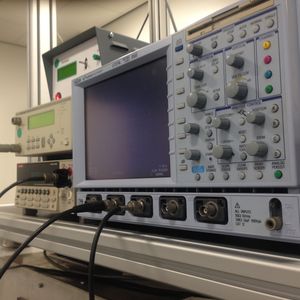Electronics
Microwave detection is afforded by a Schottky barrier diode, which converts the microwave power into a DC output, generating a voltage between 0.5 and 1 V when dropped across a 50 Ω resistor. Using an offset regulator this DC level is subtracted, and the remaining AC signal is amplified by a broadband amplifier. The time-resolved signal is routed into a digital oscilloscope with a sampling rate exceeding 1 GHz and a large internal memory. Typically, the acquisition is triggered by a fast photodiode directly illuminated by the laser pulse. Typical averaging between 10 and 1000 times allows recording of microwave conductance signals on the order of 1 mV after 100 times amplification. The signal-to-noise ratio of the total setup is therefore better than 105.
